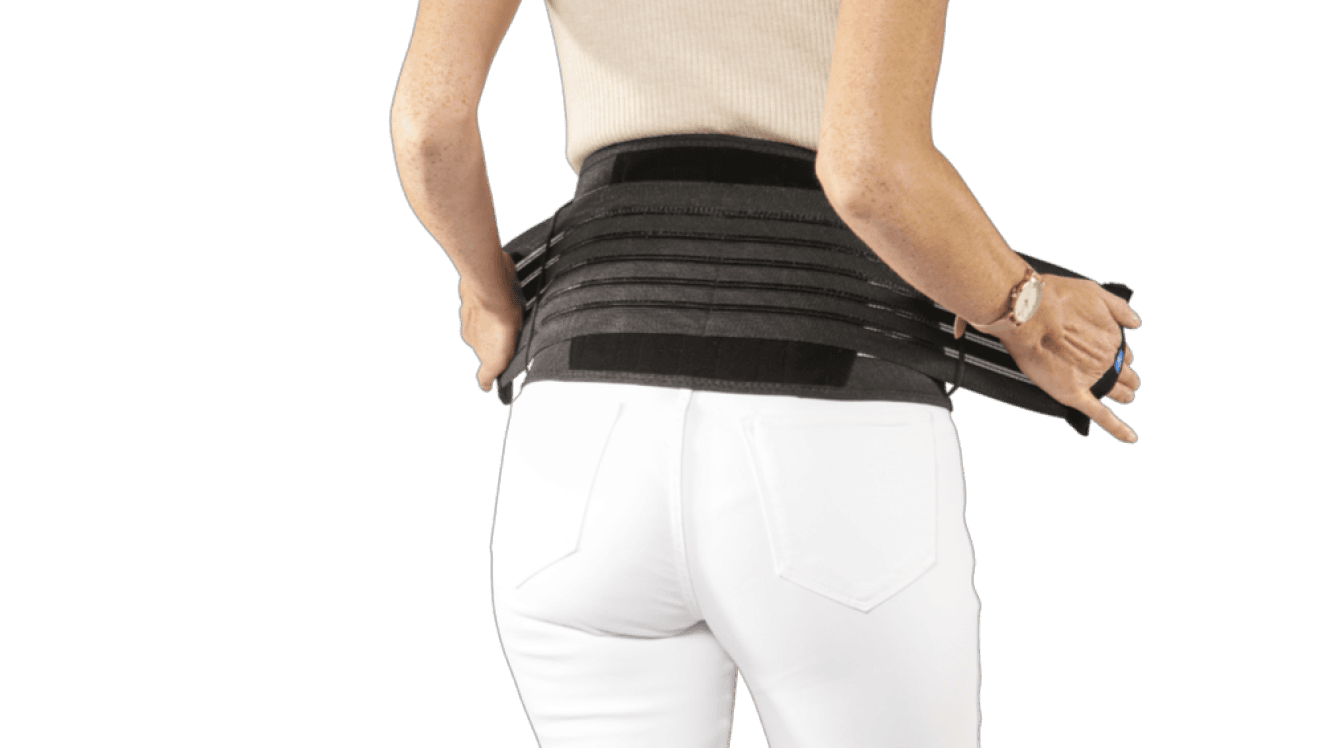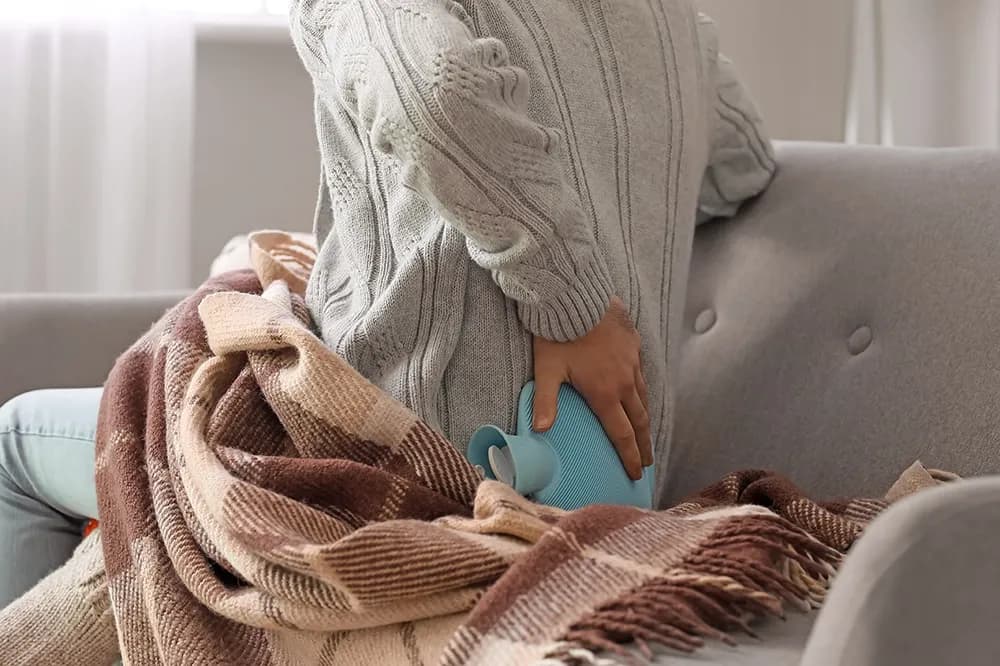Back pain
Back pain is very common. 4 out of 5 French people suffer from it in the course of their lives (1). While the pain may appear to be bone-related, it is much more likely to be muscular in origin. It can also be caused by digestive, menstrual or infectious problems.

What can you do about back pain?
The spinal column (also known as the rachis) is a complex joint made up of vertebrae, discs, muscles, tendons, cartilage, ligaments and nerves. The body puts a lot of responsibility... on its back: maintaining posture, carrying out movements, protecting the spinal cord... The price of the transition from ‘homo erectus’ to standing, back pain still plagues ‘homo sapiens’ in his contemporary lifestyle. The ‘evil of the century’ so designated in the 20th century remains the evil of the century in the 21st century too. The spine supports the weight of the upper body. A standing position that our ancestors were not used to holding.
The spinal column
The spine is the central pillar of the body. One of its main roles is to guide the many movements that the trunk makes possible: flexion, extension, rotation, inclination, etc. of the upper body. It is made up of 24 vertebrae: 7 cervical, 12 thoracic, 5 lumbar, 5 sacral forming the sacrum and 3 to 5 vertebrae forming the coccyx. Like all joints, the vertebrae are held together by numerous ligaments and muscles. They are each separated by an intervertebral disc, whose role is similar to that of a cushion: it supports weight (our own and that of everything we carry) and absorbs the shocks associated with movement.
How can you recognise the symptoms of back pain?
Excessive strain, inappropriate movement and impact, as well as wear and tear on our vertebrae and their surrounding structures, are at the root of various painful pathologies. Each component of the spine can be the cause of back pain. It is therefore important to recognise the symptoms of back pain:
Lower back pain? Lower back pain (also known as lumbago)
If you experience lower back pain, this is known as lumbago. This is a blockage that may be caused by lifting a heavy load. It is also called lumbosciatica if the pain radiates from the lower back to the foot.
Pain in the middle of the back? Back pain
If, on the other hand, you feel pain in the middle of your back, it's probably the thoracic vertebrae in the middle of your spine. Generally speaking, people who work bent over are the most affected by this pain between the shoulder blades.
Upper back pain? Neck pain
Pain in the upper back involves the cervical vertebrae: torticollis after a bad night's sleep or ‘whiplash’ after an accident are notorious for their severe pain, but cervical osteoarthritis, with its associated headaches, can also be very uncomfortable.
Back pain during pregnancy?
Like one in two women, if you suffer from back pain during pregnancy, it's perfectly normal. Don't hesitate to consult our page dedicated to this subject.
What causes back pain?
There are many possible causes of back pain. But some risk factors are more important than others. Excess weight, stress or poor posture ...
Bad postures and positions
In France, back pain is mainly caused by poor posture and positioning. 46% of French people attribute their most recent backache to them (1). At the office, in the car, carrying a heavy object or getting out of bed, it's essential to adopt good everyday habits to avoid back pain.
For example, bend your knees and keep your back straight when picking up a heavy object, avoid straightening up abruptly, get out of bed slowly and gently, and keep your head upright by relaxing your shoulders when driving (2).
Stress can cause back pain... or make it worse
Stress is the second most common cause of back pain, cited by 13% of those surveyed (1). In stressful situations, certain areas of the back contract or tense up. Stress is felt most acutely at work: monotonous tasks, job dissatisfaction, lack of recognition, etc. All of these psychosocial factors, as well as the depressed mood that can result, are likely to encourage lumbago, as well as its chronicity (3).
A sedentary lifestyle and lack of physical activity
Without sufficient physical activity, the muscles of the back become slack and weak, and no longer play their supporting role properly: this is when pain occurs. Keeping active will prevent back pain from becoming long-lasting and/or recurring. This is the theme of a major information campaign run by the French National Health Insurance, called ‘Back pain: the right treatment is movement’ (4).
The aim is to strengthen your back muscles. But don't panic! Physical activity doesn't mean high-level sport... To ensure that you can keep going over the long term, it's important to find a sport that's motivating and enjoyable. Even in the event of back pain, if it is bearable, sporting activity can be continued with the agreement of a doctor (4).
Lower back pain during menstruation
During menstruation, some women complain of lower back pain. This pain is caused by contractions of the uterus. They generally disappear on their own within a few days. If they are particularly debilitating and intensify over the months, a gynaecologist should be consulted.
What can be done to relieve back pain quickly?
Treatment for back pain consists mainly of reducing the pain with medication, heat or cold, temporary rest and support for the affected area with a collar or belt and physiotherapy. To facilitate recovery and prevent pain from persisting, it is advisable to undergo appropriate re-education, adopt a healthy lifestyle (weight and stress management, physical activity) and learn how to adopt good posture to protect the back on a daily basis. In some cases, it may be necessary to adapt the workstation and physical activities. Surgery is rare.
In the event of severe or chronic pain, consult your GP.
- Anaes / Service des recommandations et références professionnelles : Diagnostic, prise en charge et suivi des malades atteints de lombalgie chronique, décembre 2000
- Anaes / Service des Recommandations et Références Professionnelles /Prise en charge diagnostique et thérapeutique des lombalgies et lombosciatiques communes de moins de 3 mois d’évolution, février 2000.
- Collège Français des Enseignants en Rhumatologie : Item 2015 : Rachialgies. 2010-2011
- https://www.msdmanuals.com/fr/professional/troubles-musculosquelettiques-et-du-tissu-conjonctif/douleurs-cervicales-et-lombaires/sciatique#%C3%89tiologie_v908522_fr


